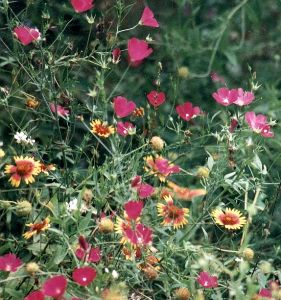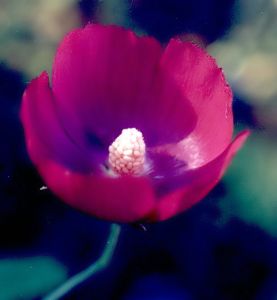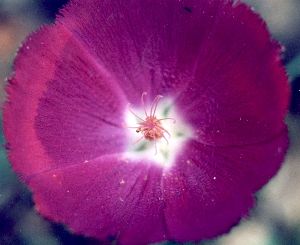Wine-Cup
by Valerie (May 23, 2000)
revised August 24, 2003

The wine-cup, or poppy-mallow (Callirhoe digitata), is one of the most brilliant of our wildflowers. It is a low, sprawling perennial with a thick, tuberous root, capable of surviving droughts and poor, rocky soil. It doesn't usually grow in large groups, more often there are a few scattered plants among other wildflowers. It seems to do well in partial shade and we have a number of plants scattered throughout the gardens.
An unusual feature of this flower is its foliage, which is different during the winter, when it grows in a low cluster, with wide scalloped leaves, and the spring and summer, when it sends out long stems for the flowers but also produces thin, deeply-notched leaves. The magenta blossoms attract many bees and small wasps. While I've never been able to start standing wine-cup from seed (all our plants were salvaged from a construction site), I have been able to germinate the seeds of C. involucrata. Although the germination rate was low, once the seedlings put out a couple of small leaves, they did very well and handled the heat of their first summer with no ill effects. |
 There are two similar species of wine-cup that grow in this area. While the flowers look the same, the other species (Callirhoe involucrata) tends to be a bit more robust, with larger seed heads, more flowers per plant, and more foliage. The more slender and delicate species that we grow is sometimes called standing wine-cup to differentiate it from the other, but they both tend to grow up to about 1½ feet, then sort of flop over. The easiest way to tell them apart is the presence of what looks like an extra set of three bracts below the usual five right next to the petals. This occurs only on C. involucrata and is called a involucel.
There are two similar species of wine-cup that grow in this area. While the flowers look the same, the other species (Callirhoe involucrata) tends to be a bit more robust, with larger seed heads, more flowers per plant, and more foliage. The more slender and delicate species that we grow is sometimes called standing wine-cup to differentiate it from the other, but they both tend to grow up to about 1½ feet, then sort of flop over. The easiest way to tell them apart is the presence of what looks like an extra set of three bracts below the usual five right next to the petals. This occurs only on C. involucrata and is called a involucel.
